You can manage tasks within the pre-construction schedule on the Gantt Chart. This is a quick and efficient way to manage the overall duration of the pre-construction activities and see dependencies between tasks. So that you can see how the increase in duration of one task impacts other tasks and the overall duration in general.
All the activities are distributed through the timescale. You can regulate positions of activity bars on the timescale and adjust duration of tasks.
Here you can see that the page is divided into two parts. The left part accommodates the list of tasks and sub-tasks, the right part accommodates the Gantt Chart for planning the pre-construction activities and their distribution across the timeline.

The Tasks list shows the list of sub-tasks grouped within the parent (composite) tasks. To view sub-tasks within a specific task, you can expand it by clicking the icon.
Each task and sub-task represents an activity which is shown on the Gantt Chart as an activity bar. By default, duration of each activity equals one day and all activities start from the same day. The task (uniting multiple sub-tasks) is shown as progress activity bar on the Gantt Chart. Its length is determined automatically from the scope of all sub-tasks within it.
For each task on the list, the following information is displayed:
| Number | Ordinal number of the Task or sub-task on the list. The system assigns it automatically. |
| Task Name | Name of the Task or sub-task. |
| Resource | Supplier or Contractor who can provide a specific service for Task completion. |
| Type | Type of the task:
|
| Pred. | Number of the task which is a predecessor for the current task.
The parameter in the Pred. column can take one of the following values:
|
| Duration | Planned duration of the task in days. |
| Start Date | Start date of the task or sub-task. |
| End Date | End date of the task or sub-task. |
| % | Completion percentage of the task or sub-task.
Completion percentage of the composite task uniting multiple sub-tasks is calculated on the basis of completion percentage of its sub-tasks. |
| Done, % | Click the Done button to track completion of the task. |
| Notes | Notes about the task. |
Tracking Completion of Tasks
You need to track completion of tasks from the pre-construction schedule on a regular basis.
You can track the progress of each task in multiple ways:
- when editing the sales schedule and clicking the Done button
- when editing the task and adjusting the completion percentage by moving the slider
- when managing tasks on the Gantt Chart
Tracking Completion of Tasks – Way 1
- Open the pre-construction schedule for editing.
- On the list with tasks locate the one which progress you want to track.
- Click Done.
- Click Progress.
![]()
This will add 50% to the task completion percentage. If you click this button twice, the system will consider the task to be completed.
If the task is a part of a composite (parent) task, the overall completion of this composite task will also change depending on the task duration.
Note
You cannot track the progress of the parent task, as it is calculated automatically on the basis of the sub-tasks within it.
Tracking Completion of Tasks – Way 2
- Open the pre-construction schedule for editing.
- On the list with tasks locate the one which progress you want to track.
- Hover over the task until the action icons appear.
- Click the Edit
 icon.
icon. - On the Pre-Construction Schedule Task page, locate the slider to track completion of the task.

- Move the slider left to indicate the current progress on the task. Value in the Completion, % box will change.

- When complete, click Process.
The completion percentage of the composite task is calculated on the completion percentage of its sub-tasks.
Note
You cannot track the progress of the parent task, as it is calculated automatically on the basis of the sub-tasks within it.
Tracking Completion of Tasks – Way 3
- Switch the list of tasks to the Gantt Chart view.
- Locate the task which progress you want to update.
- Hover over the left edge of the activity bar of this task until the mouse pointer changes from
 to
to  .
. - Hold the left mouse button and drag the mouse pointer to the right side of the activity bar. The progress will be changing in the appeared tooltip.

- Release the left mouse button when complete.
- When complete, click Process.
Adding Tasks to the Gantt Chart
- Open the pre-construction schedule which you want to add tasks into.
- Under the list with tasks, locate the Gantt Chart button and click it.
The page with the list of tasks and the Gantt chart opens, as follows:

On the list with tasks, you can see the following:
| Regular Task | Generic task. There is no flag in the Type column.
If the task is comprised of other sub-tasks, there will be the ‘SUM’ flag in the Type column. |
| Sub-Task | Sub-Task that is added for a specific task. |
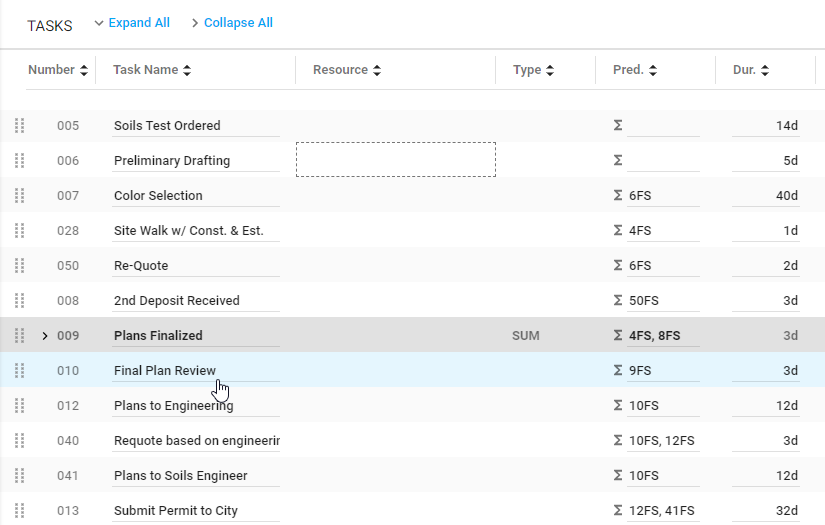
The Tasks list shows the hierarchy of all tasks that should be completed for successful completion of all pre-construction activities from the schedule.
By default, the hierarchy of tasks is taken from the Pre-Construction Schedule Template you have chosen when creating the pre-construction schedule.
You can modify this structure and add new tasks, as well as sub-tasks within it.
Note
You cannot either edit or delete the task labeled as ‘Start’. This is a default task should be presented in each pre-construction schedule.
To add a new Task:
- Click the Add Task
 icon (located above the list with tasks). A new row with the generic task name appears on the list.
icon (located above the list with tasks). A new row with the generic task name appears on the list. - Double-click the row and enter the task name.
- When complete, click Process.
If you need to add a task under a composite task, click the Add Task ![]() icon which appears when you hover over this composite task.
icon which appears when you hover over this composite task.
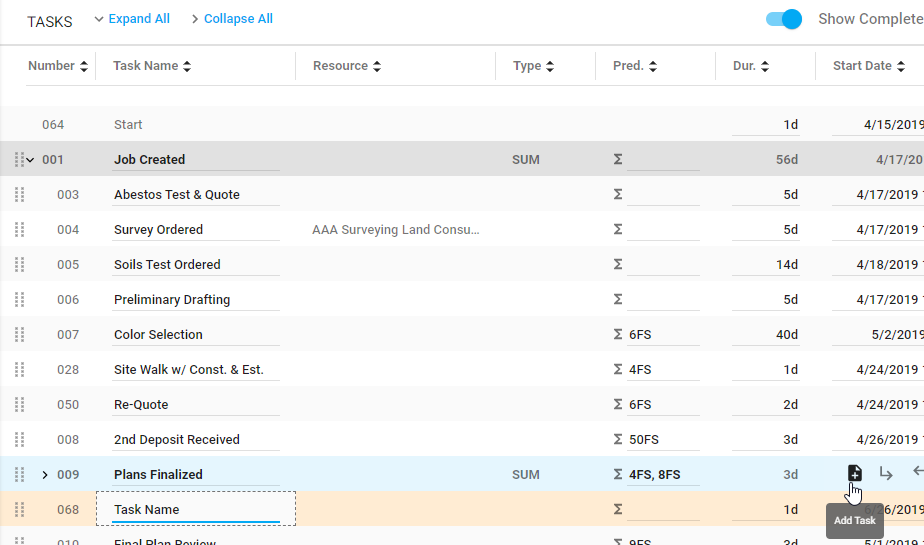
To add a new Sub-Task:
You can add sub-tasks for generic tasks.
- On the list with tasks, locate the task which you want to add a sub-task for.
- Hover over it until the action icons appear.
- Click the Add Sub-task
 icon.
icon. - Enter the name for a new sub-task.
- When complete, click Process.

Note
You cannot create a sub-task for the task labeled as ‘Start’.
To edit the task:
- On the list with tasks, locate the one you want to edit.
- Hover over the task until the action icons appear.
- Click the Edit
 icon.
icon.
For the details on editing tasks, see the Editing the Task.
To delete Tasks and Sub-tasks:
You can delete the Tasks and Sub-Tasks that you added.
- On the list with tasks, locate the task or sub-task you want to delete.
- Hover over it until the action icons appear.
- Click the Delete
 icon.
icon. - Confirm the removal of the task or sub-task.
- When complete, click Process.
To convert the sub-task into the task:
You can convert the existing sub-task into a generic task.
- On the list with tasks, locate the sub-task you want to convert into a task.
- Hover over the sub-task until the action icons appear.
- Click the Not sub-task
 icon.
icon. - When complete, click Process.
The sub-task will be moved one level up. If you were using the multi-level hierarchy of tasks, you may need to repeat the same procedure once more.
To manage order of tasks on the Tasks list:
You can change the order of tasks and sub-tasks in the Tasks list. Please consider the following while re-ordering tasks:
- You can re-order tasks within the same composite task and you can move them to another composite task..
- You can re-order sub-Tasks within the same task and move them to another task.
- You cannot change the order (rank) of the task labeled as ‘Start’.
- On the list with tasks, locate the task which position on the list you want to change.
- Drag the part of the row to the appropriate position on the list.
- When complete, click Process.
Note
You cannot change the position of the first task labeled as ‘Start’. It should be always at the top of the list of tasks.
To expand all Tasks on the Tasks list:
Above the Tasks list, locate the Expand all button and click it. All the Tasks within the pre-construction schedule will be expanded.
To collapse all Tasks on the Tasks list:
Above the Tasks list, locate the Collapse all button and click it. All the Tasks within the pre-construction schedule will be collapsed.
To hide completed Tasks:
- Above the list with tasks, locate the Show completed tasks toggle.
- Move the toggle left.
All the completed tasks (which completion percentage equals 100%) will be hidden from the list and on the Gantt Chart.
To adjust the position of the activity bar on the timescale:
- Hover over the activity bar which position on the timescale you want to adjust.
- Drag the activity bar across the timescale.
- When complete, click Process.
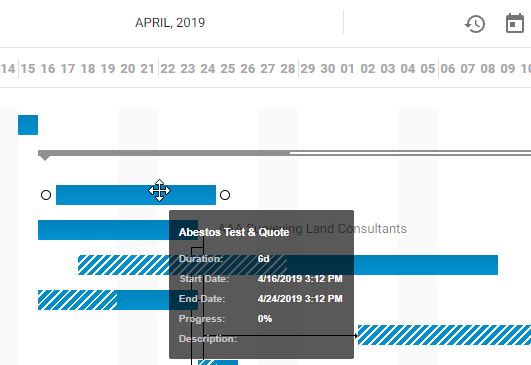
You can also adjust the position of the composite task (which includes tasks or sub-tasks). When you change the position of the composite task, all the tasks and sub-tasks within it are also moved along the timescale.
To adjust the duration of the Task:
You can adjust the duration of tasks and sub-tasks.
- Hover over the activity bar which duration you want to increase or decrease. Once you hover, close to the left and right edges of the activity bar the circles appear.
- Drag the left-side or right-side circle to adjust the duration of the Tab. When you drag the circle, you can see how duration of the activity is changing in the tooltip.
- When complete, click Process.
Duration of the composite task is calculated automatically by the system on the basis of all tasks and sub-tasks within it. You cannot adjust duration of the composite task.
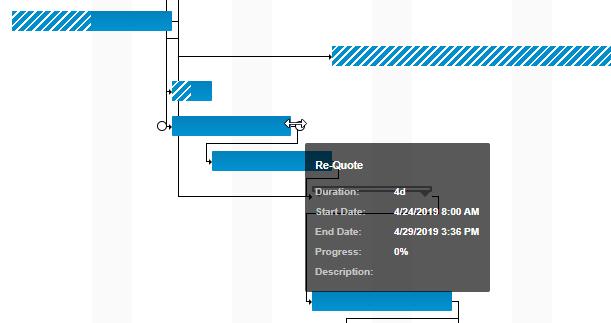
To manage dependencies between Tasks:
You can manage dependencies between Tasks and in this way indicate that some task can be started only when a specific task is completed or starts.
- Hover over the activity bar which you want to set the dependency for. Once you hover, close to the left and right edges of the activity bar the circles appear.
- Drag the line from the one activity bar to the circle of the other activity bar. The dependency line appears between the two activity bars.
- When complete, click Process.
You can also set dependencies between composite tasks in the way similar to setting dependencies between tasks. You can set dependencies between tasks and sub-tasks from different composite tasks.
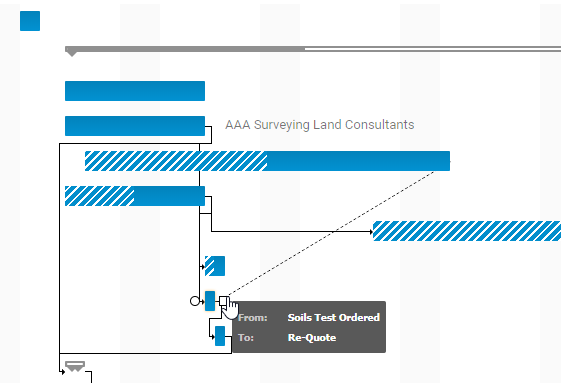
Consider the following relationship types between the two activities (Tasks):
| FS (Finish to Start) | A predecessor task must finish before a successor task can start.
To define this relationship type: Drag the arrow from the right edge of a predecessor task to the left edge of a successor task. When FS type is set, a successor task starts from the finish point of a predecessor task. |
| SS (Start to Start) | A predecessor task must start before a successor task can start.
To define this relationship type: Drag the arrow from the left edge of a predecessor task to the left edge of a successor task. When SS type is set, a successor task starts from the start point of a predecessor task. |
| FF (Finish to Finish) | A predecessor task must finish before a successor task can finish.
To define this relationship type: Drag the arrow from the right edge of a predecessor task to the right edge of a successor task. When FF type is set, a successor task finishes at the finish point of a predecessor task. |
| SF (Start to Finish) | A predecessor task must start before a successor task can finish.
To define this relationship type: Drag the arrow from the left edge of a predecessor task to the right edge of a successor task. When SF type is set, a successor task finishes at the start point of a predecessor task. |
Instead of dragging lines from one activity bar to the other, you can just enter the appropriate number of the task and relationship type into the field.
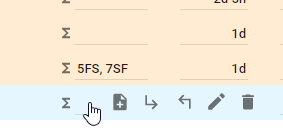
You can add multiple relationships between activity bars, in this case several values will be displayed in the field labeled as ∑.
To delete the no longer needed relationship between activity bars, double click the field with the predecessor value and delete the no longer needed value.
To manually enter a predecessor task and its connection type:
- Double-click the text field (with the ∑ label) and enter the number of a predecessor task and a connection type (for example, 16SS where 16 is a number of a predecessor task and SS is a Start to Start connection type).
- When complete, press Enter.
You can add multiple predecessor tasks and define delays between a specific task and other tasks on the timeline.
- On the list with Tasks, locate the one which you want to add predecessor tasks for.
- Click the Add predecessors
 icon.
icon. - In the Predecessor Kit for a Task Name form, define the following information about a predecessor task:
Predecessor Select a predecessor task from the ones registered in the current schedule. Relationship Select the relationship type from the following ones: - Finish to Start
- Start to Start
- Finish to Finish
- Start to Finish
Delay Select the delay or overlap in the relationship between tasks, as follows: ‘+’ = Delay
A successor task starts some days after the end of a predecessor task.
‘-‘ = Overlap
A successor task starts some days prior to the end of a predecessor task. In this case, a successor task overlaps a predecessor task.
Days The number of days a successor task starts before/after the end/start of a predecessor task. 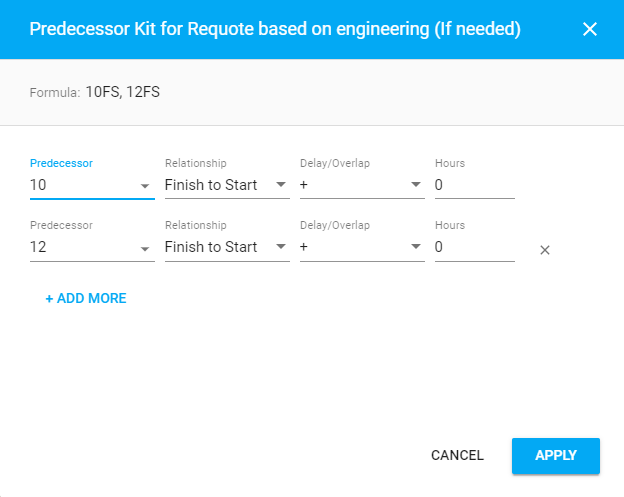
- When complete, click Apply.
- Click Process.
The specified delay and overlap values will be shown as lags when you hover over a relationship arrow on the Gantt Chart.
To manage view of Tasks on the Gantt Chart:
You can switch view of Tasks on the Gantt Chart among the following views:
- Month
- Week
- Day
Above the top right part of the Gantt Chart, locate the Switch view ![]() icon.
icon.
Click this icon and select the view for showing tasks on the Gantt Chart.
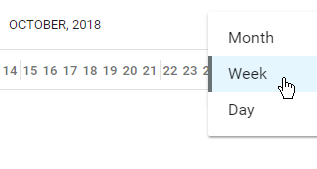
While navigating through the Gantt chart, you may need to quickly return to the current date to see the due tasks.
Above the top right part of the Gantt chart, locate and click the Back to Current Date ![]() icon. This will return you to the current date on the Gantt chart.
icon. This will return you to the current date on the Gantt chart.

